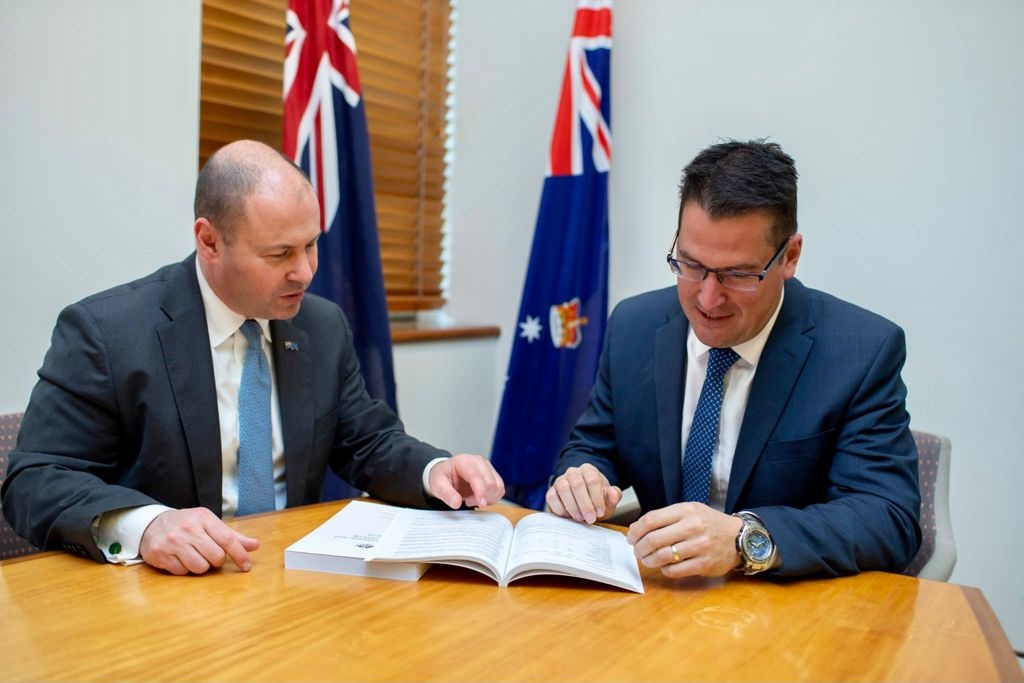
The Treasurer and Minister for International Development looking over the 2021 budget papers
Development assistance in the news: don’t mention the aid budget
By Stephen Howes
21 May 2021
Kudos to Sky News journalist Kieran Gilbert who, in the follow-up to last week’s budget, put questions on foreign aid to all three of the Prime Minister, the Treasurer and the Minister for International Development.
The Prime Minister got just one question, about why we are cutting aid. In reply he insisted that “we continue to increase our support”.
Gilbert had a more extended exchange with the Treasurer on aid. When it was put to him that the aid program was down, and that we were one of the least generous donors, the Treasurer responded that the aid program was significant and effective, and that we’re doing everything we can to help our neighbours.
The longest discussion was with the Minister for International Development, Zed Seselja. At one point, Gilbert asked the Minister what the Official Development Assistance (ODA) total was. Seselja replied without answering the question. Gilbert asked again, and again no answer.
If the minister for aid can’t actually say what the aid budget is, something has gone wrong. It is hard to understand, but it seems to be part of a strategy to avoid any permanent increase in development assistance.
Seselja wouldn’t be drawn on how much we are actually spending on aid, but was, like his boss, keen to deny there had been a cut. I ran through the numbers on my budget night blog, and here they are again in the figure below, starting with the last non-Coalition aid budget from 2012-13. These are official numbers, adjusted by official CPI estimates and projections. The numbers are actuals up to 2019-20 and budget numbers thereafter, including forward estimates.
There is an increase in the 2020-21 year (for which I was the first to give the government credit), and aid then falls every year for the next four.
Australian foreign aid, adjusted for inflation
As I wrote in my budget blog this year and as the Minister emphasised in his interview, aid is falling next year in part because the government is planning to spend more of its COVID response package this year and so less next. But the aid cuts story is about the next four years. Aid falls in each of them. Looking at the figure above, there is no other way to interpret last week’s aid budget other than as a cut in foreign aid in the middle of a pandemic.
By 2024-25, the government is budgeting foreign aid to be at its lowest level since 2007.
It is telling to compare aid with domestic expenditure. We do see a reduction in domestic spending in the coming year (2021-22) as the immediate COVID support programs have been wound back. But domestic spending stabilises thereafter, unlike aid which continues to fall. The immediate and massive spike in domestic spending in response to COVID also stands out relative to our delayed and anaemic foreign aid response.
Australia’s foreign aid and domestic spending: a study in contrasts

Both figures set equal to 1 for their average in 2017-18 and 2018-19 (pre-COVID average). Domestic spending is total spending minus aid minus interest. Figures are adjusted for inflation.
The ratio of aid to total expenditure is set to halve from 1.32% in 2012-13 to 0.68% in 2024-25. That is a historic shift, in the wrong direction.
Seselja was also at pains in his interview to dispute the significance of the recent OECD finding that our aid to GNI ratio was 0.19% in 2020.
As I mentioned in my blog on the latest OECD numbers, the OECD calculates aid to GNI (or national generosity) ratios on a calendar year basis, whereas Australia budgets July to June. Australia spent 11% less in calendar year 2020 than calendar year 2019 (pre-COVID). According to the OECD – based on information that must have come from Australia – the reason was “slowed spending as a result of the pandemic”.
Our 2020-21 fiscal year ODA to GNI ratio is slightly higher at 0.22% than our 2020 calendar year ratio (the 0.19%). However, this changes little. One of the main points of my blog is that the latest OECD data show that only two out of 22 traditional OECD donors are less generous than us. This is true whether we use 0.19 or 0.22.
Sky gave aid much better coverage post-budget than the ABC. As far as I know, the ABC only interviewed the Minister for International Development about aid on Pacific Beat. The ABC seems to have assigned its coverage of aid to Pacific Beat. That’s unfortunate, because the aid budget these days is always kind to the Pacific. But even now, only about one-third of aid goes to the Pacific. A more global perspective is needed.
The government should be asked a lot more questions about foreign aid. Our share in the international aid effort has more than halved in the last decade. We have gone from being a donor of above-average generosity to being one of the least average donors. We are planning to spend less aid every year for the next four. And – strange but true – the government refuses to say how much we are actually spending on aid.
Good on Sky for trying to get some response from government ministers on these important points. I hope that the ABC and others will follow suit.
Check out all the latest aid numbers at the Australian Aid Tracker.
Disclosure
This research was undertaken with the support of The Bill & Melinda Gates Foundation. The views represent those of the author only.
About the author/s
Stephen Howes
Stephen Howes is Director of the Development Policy Centre and Professor of Economics at the Crawford School of Public Policy at The Australian National University.
